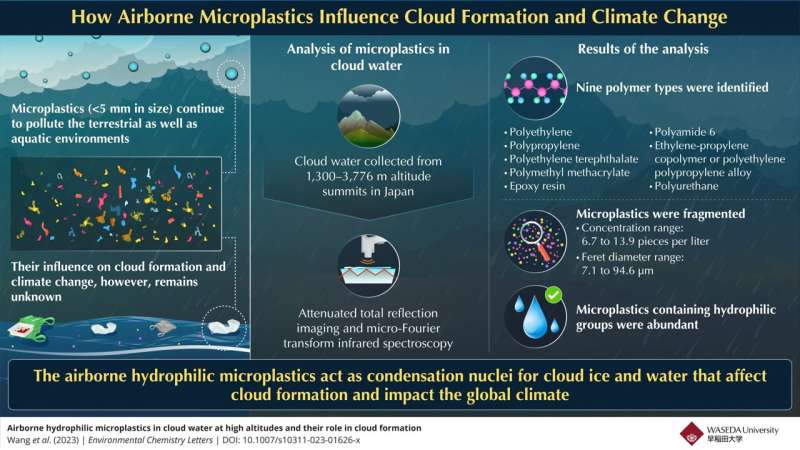This article has been reviewed according to Science X's editorial process and policies. Editors have highlighted the following attributes while ensuring the content's credibility:
fact-checked
trusted source
proofread
New study analyzes airborne microplastics in clouds

Plastic particles less than 5 mm in size are called "microplastics." These tiny bits of plastic are often found in industrial effluents or form from the degradation of bulkier plastic waste. Research shows that large amounts of microplastics are ingested or inhaled by humans and animals alike and have been detected in multiple organs such as lung, heart, blood, placenta, and feces.
Ten million tons of these plastic bits end up in the ocean, are released with the ocean spray, and find their way into the atmosphere. This implies that microplastics may have become an essential component of clouds, contaminating nearly everything we eat and drink via "plastic rainfall." While most studies on microplastics have focused on aquatic ecosystems, few have looked into their impact on cloud formation and climate change as "airborne particles."
In a new study led by Hiroshi Okochi, Professor at Waseda University, a group of Japanese researchers has explored the path of airborne microplastics (AMPs) as they circulate in the biosphere, adversely impacting human health, and the climate. Their study was recently published in the journal Environmental Chemistry Letters with contributions from co-authors Yize Wang from Waseda University and Yasuhiro Niida from PerkinElmer Japan Co. Ltd.
"Microplastics in the free troposphere are transported and contribute to global pollution. If the issue of 'plastic air pollution' is not addressed proactively, climate change and ecological risks may become a reality, causing irreversible and serious environmental damage in the future," explains Okochi.
To investigate the role of these tiny plastic particles in the troposphere and the atmospheric boundary layer, the team collected cloud water from the summit of Mt. Fuji, south-eastern foothills of Mt. Fuji (Tarobo), and the summit of Mt. Oyama—regions at altitudes ranging between 1,300 and 3,776 meters. Using advanced imaging techniques like attenuated total reflection imaging and micro-Fourier transform infrared spectroscopy (µFTIR ATR imaging), the researchers determined the presence of microplastics in the cloud water, and examined their physical and chemical properties.
They identified nine different types of polymers and one type of rubber in the AMPs detected. Notably, most of the polypropylene that was detected in the samples was degraded and had carbonyl (C=O) and/or hydroxyl (OH) groups. The Feret diameters of these AMPs ranged between 7.1 µm and 94.6 µm, the smallest seen in the free troposphere.
In addition, the presence of hydrophilic (water loving) polymers in the cloud water was abundant, suggesting that they were removed as "cloud condensation nuclei." These findings confirm that AMPs play a key role in rapid cloud formation, which may eventually affect the overall climate.
Accumulation of AMPs in the atmosphere, especially in the polar regions, could lead to significant changes in the ecological balance of the planet, leading to severe loss of biodiversity. Okochi concludes by saying, "AMPs are degraded much faster in the upper atmosphere than on the ground due to strong ultraviolet radiation, and this degradation releases greenhouse gases and contributes to global warming. As a result, the findings of this study can be used to account for the effects of AMPs in future global warming projections."
More information: Yize Wang et al, Airborne hydrophilic microplastics in cloud water at high altitudes and their role in cloud formation, Environmental Chemistry Letters (2023). DOI: 10.1007/s10311-023-01626-x
Provided by Waseda University





















